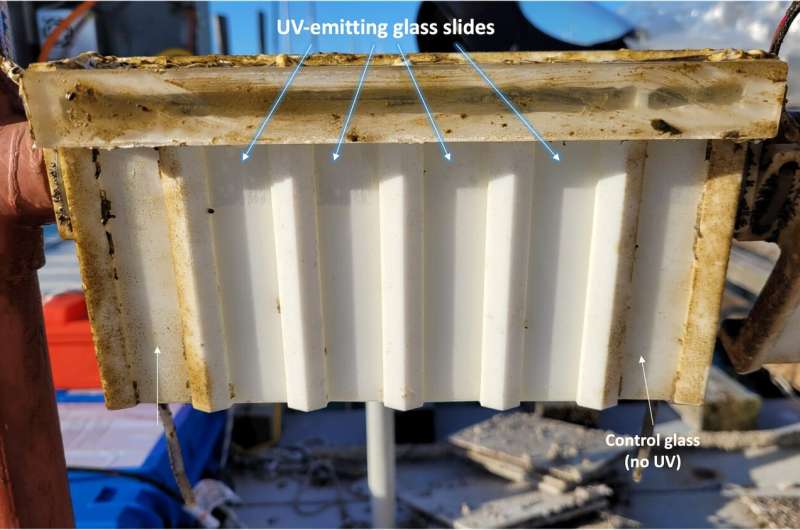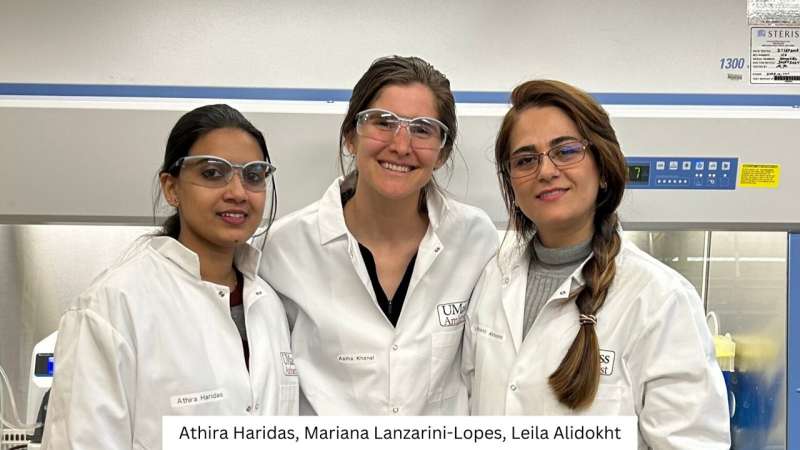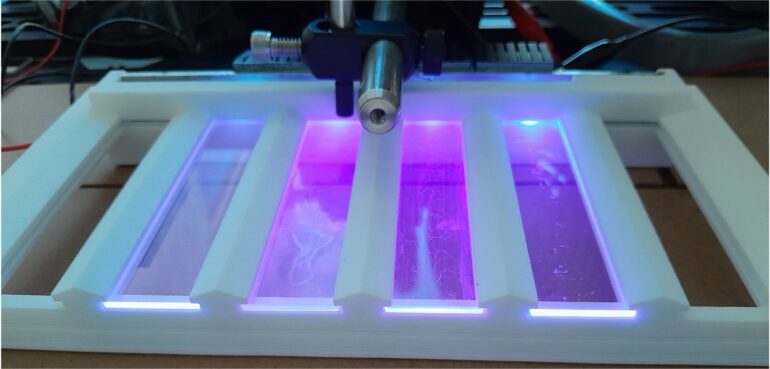A group of researchers led by University of Massachusetts Amherst engineers have created ultraviolet (UV) rays-emitting glass that can reduce 98% of biofilm from growing on surfaces in underwater environments, as reported in the journal Biofilm.
Biofilm is a slimy layer of various types of microorganisms that grows on wet surfaces. “If you look down your sink and touch the inner side of it—that slimy substance is biofilm,” says Mariana Lanzarini-Lopes, assistant professor of civil and environmental engineering at UMass Amherst, and a corresponding author on the paper.
Biofilm is a significant issue for underwater applications. The United States Navy estimates that biofilms cost its fleet between $180 and $260 million annually. Biofilm growth on all underwater surfaces increases a ship’s drag and subsequent fuel usage, as well as corrosion damage on ships or oceanographic equipment.
Biofilm can also fog up windows used for cameras and other sensing devices that rely on transparency, and transport non-native species across the seas.
Current solutions for dealing with biofilm rely on chemical agents like biocidal coatings to kill the organisms or nonstick coatings to prevent biofilms from attaching in the first place. However, these methods can have negative effects on the ecosystem and only last for a short duration.
As an alternative to these chemical methods the UMass Amherst team developed biofilm-resistant glass using UVC radiation, the shortest and most effective at disinfecting wavelength of UV radiation.

The glass treated with ultraviolet rays (inside), had 98% less biofilm growth than the untreated glass (outside). © University of Massachusetts Amherst
Lopes’s lab has already demonstrated that UV side-emitting optical fiber can distribute UVC radiation in small channels, like medical equipment (i.e. endoscopes, catheters and respirators), home devices (coffee makers and refrigerators) and water storage/distribution systems (pipes, bladders, membranes) to inactivate pathogenic organisms and prevent bacteria growth on surfaces.
“A lot of people know about UV for disinfecting surfaces, air and water,” says Lopes. “People started using it a lot more especially because it was really effective for disinfection of the SARS-CoV-2 virus.”
However, in an underwater environment, it’s not as simple as shining UV light onto glass. “We cannot use traditional light sources to distribute light evenly on the surface,” for several reasons, says Leila Alidokht, postdoctoral research associate in Lopes’s lab and lead study author. Light becomes weaker as it moves away from the source, making it difficult to cover large surface areas. The UV waves can also be disrupted by how murky the surrounding water.
Uneven distribution of the UV light gives biofilm-forming microorganisms a foothold and leaves the whole surface vulnerable: “If the biofilm can attach to a part of the surface, it can spread to other parts,” she adds.
The team’s solution is a silica-nanoparticle coating on the glass. “The UV LED is connected from the cross-section of the glass,” Alidokht describes. “As UV enters the glass, we scatter the UV from inside of the glass to the outside,” using these light-scattering nanoparticles. The silica does not absorb the UV rays. The waves continue to bounce off the nanoparticles and through the glass interior which enables an evenly “glowing” glass surface.
To test it, the researchers, in partnership with Florida Tech and the Navy, submerged this UV-emitting glass in the waters of Port Canaveral, Florida for 20 days. Compared to untreated glass, this glass reduced visible biofilm growth by 98%.

Lanzarini-Lopes (center) with Alidokht (right) and graduate research assistant, Athira Haridas (left). © University of Massachusetts Amherst
“Contrary to external UV irradiation technique, UV-emitting glass inhibits biofilm formation directly at the surface of interest—the surface itself serves as a UVC source,” says Alidokht.
She is excited that this discovery opens the door for diverse disinfection applications. “The developed technology can be used for disinfection of transparent surfaces such as windows of ships, flotation spheres and moored buoys, camera lenses and sensors for oceanographical, agricultural and water treatment applications,” she says.
The team has received a provisional patent for their discovery.
Now that the team has proven that this glass effectively resists biofilm formation (known as biofouling), they are excited to optimize their discovery: testing long-term applications, assessing any effects on the environment and creating larger surface areas.
Another future avenue of exploration: “We’re also trying to prevent biofilm on camera lenses,” adds Lopes. “The maininhibitor of the length of time for deployment [of underwater cameras] is biofouling, so as long as you can decrease the rate of biofouling, you can increase how long you deploy all this optical equipment.”
More information:
Leila Alidokht et al, UV emitting glass: A promising strategy for biofilm inhibition on transparent surfaces, Biofilm (2024). DOI: 10.1016/j.bioflm.2024.100186
Provided by
University of Massachusetts Amherst
Citation:
Research team creates biofilm-resistant glass for marine environments (2024, April 2)



